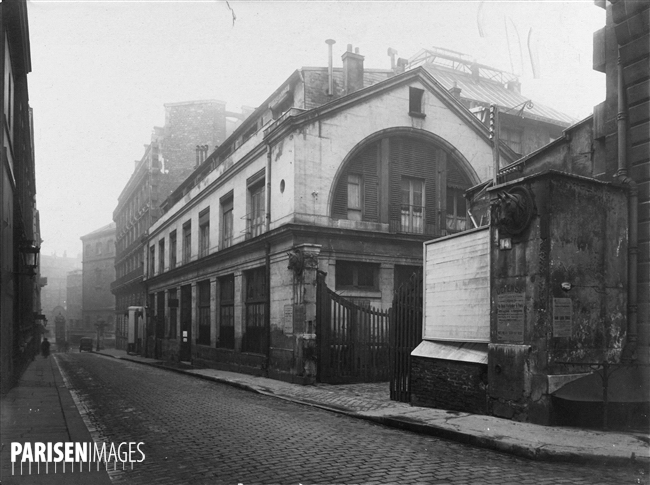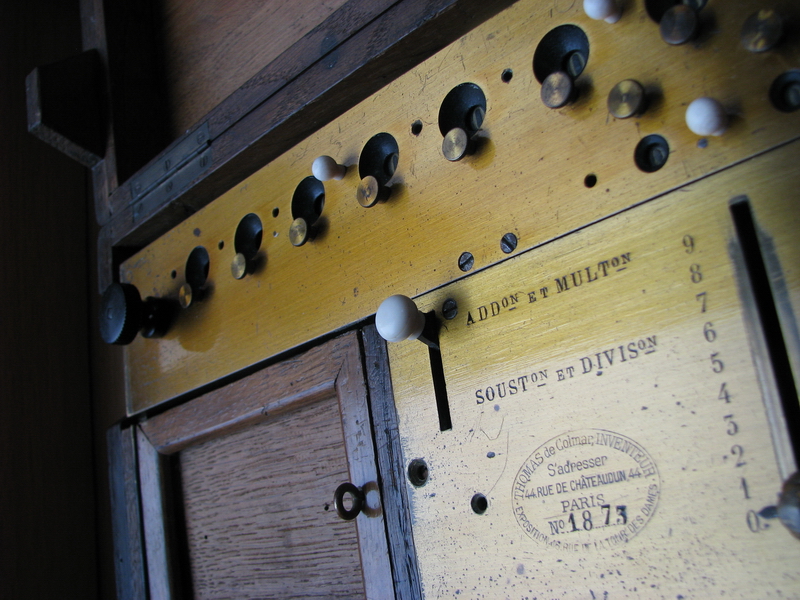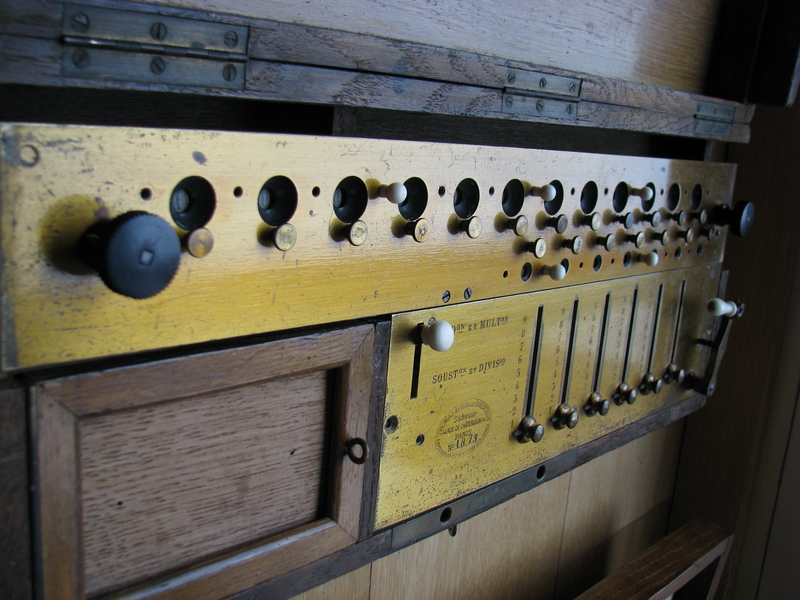Arithmomètre de Thomas
In a confusing turn of events, I finally managed to acquire what is essentially the jewel in the crown of my collection - an actual Thomas arithmometer, made by the firm established by the original inventor, Charles Xavier Thomas de Colmar. In fact, I managed to acquire two. First, we will discuss the machine I found first, in France. It is of course not very early - it has serial number N°2158 and dates to 1884. It is the so called "1865B" model, middle sized with 8 x 9 x 16 digits, and constructed according to the 1865 patent.For everything related to Arithmometers, I cannot recommend enough the website by Valéry Monnier, who made unearthing information about these machines more or less his life's work.
We will first take a stroll through 19th century Paris, and see where the machine was constructed.
The entire history of the Arithmomètre is situated in Paris, within a 500 m radius, and narrowly connected to the insurance companies "Le Soleil" and "L'Aigle" of Charles Xavier Thomas de Colmar. "Le Soleil" was established in 1829 at 13 Rue du Helder, Paris. The building, purchased by Charles Thomas in 1823, still exists. Most of the development and manufacture of early arithmometers, including the "piano" arithmometer of 1855, must have taken place in this very spot. The workshop was, at this point, headed by Mr. Hoart.
In 1868, Le Soleil moved to a new building at 44 Rue du Châteaudun - and so did the arithmometer manufacture.
Or rather, since the increasing production of arithmometers and the presence of an industrial machine shop with lathes, drilling machines, milling machines, ... was probably largely incompatible with the insurance business, the workshop and exposition space for the machines moved to 16 Rue de la Tour-des-Dames. It is a 400m walk along the rue Blanche passing the Church of the Trinity. This building, where my machine was constructed, was demolished, and an electricity substation was constructed on the spot in 1926, which was restored and is still there, albeit with a different function. However, through the wonderful internet, and with the help of the Musée Carnavalet and thanks to the photographer Charles Lansiaux, we do have a picture of the workshop of Thomas de Colmar, as it was in 1919:

image copyright Charles Lansiaux / Musée Carnavalet / Roger-Viollet
In 1870 Charles Xavier Thomas de Colmar dies, and is succeeded as president of the Arithmometer (and perhaps more importantly, insurance) business by his son Louis Nicolas André Thomas de Bojano. This will still not take us to the manufacture of my machine though, because Thomas de Bojano also dies, in 1881. In turn, he is succeeded by his cousin, Neulif Charles Raoul Edmond de Granges de Rancy, the son of Charles Xavier's daughter Charlotte, who died very young. He is also directeur of "La Compagnie du Soleil" until 1884, when he retires, aged 51, probably due to ill health, but not before having been formally responsible for the birth of my arithmometer in 1884! He dies in 1890.
While the Compte de Rancy was probably more preoccupied with his health problems than with arithmometer manufacture, the master-mechanic who had probably been doing all the hard work behind the scenes, Louis Payen, minded the shop, and this since approximately 1875. In 1887, he formally takes over the arithmometer business, and starts putting his own name on the machines, improving them continuously along the way. This is probably the point where the fate of the arithmometer company is decoupled from the insurance business, and the social seat of the arithmometer company moved away from the Rue Châteaudun to the Rue de la Tour-des-Dames. On machines returning to the workshop for maintenance, the address is adapted, and the new "Siège Social" stamped into the top plate below the seal. Payen in turn dies in 1901. However, his widow, Léontine Payen, keeps the business going until 1915, even patenting improvements in 1907! The business is then sold to Alphonse Darras, devil-do-all, who had earlier been involved in selling precision mechanics, telegraphs, counters of all sorts, and held a patent for the "cinématographe", a camera which could also serve as a movie projector. The first world war made production increasingly difficult, some stock was sold off, but finally the the company was liquidated, probably in 1920.
Darras held shop at the 116 Blvd. St. Germain, over 3km away, and at the other side of the Seine, but it is uncertain whether manufacturing and stock ever moved there.
Now, about this particular machine, N° 2158
Somewhere during its life, a problem developed with one of the numeral wheels in the counter register, which required quite a bit of work to rectify. I would venture to think that this was done relatively early on in the life of the machine, by an independent mechanic who glued his card to the inside of the lid, proclaiming to be specialised in the repair of all brands of calculating machines and typewriters.
G. Bernard & Co, Boulevard de Strasbourg 25, Paris Xème - and there is no telephone number yet. Also, no trace of this firm can be located today, except of course the building.

I reckon it is Mr. Bernard who is responsible for the differently engraved, but otherwise skillfully made numeral wheel in the counting register.


There is no record of who originally bought the machine and why, but we can pick up the trace in the 1930s, when it was bought by the owner of a quincaillerie (it sounds so much better in french - but it is a hardware store really) in a small village south of Paris. Recently, his daughter, in her 80s, sold the machine to an antiques dealer, who placed it on his website at an attractive price. During a web search, I found the advertisement, e-mailed, called, we agreed on a date and time, I asked to reserve the machine for me until I got there, cleared my agenda, and jumped into the car for the 450km drive to a small village south of Paris.
The machine looked a little worse for wear. The lid was damaged, where the marquetry work was missing three letters.

The machine itself was very stiff in operation, and the tens' carry was faulty. A spring for the main register zeroing knob seemed to be missing. A few of the little knobs for setting the registers manually (which, incidentally are present on both counter and result register in these machines) were missing or spinning freely (taken off in the picture below).

Also, the middle hinge of the box was missing, and the wooden protrusion on the right side of the lid (the one that always breaks off...) had, obviously, broken off.
So, I worked some magic on some bits of the machine. It turns out the little knobs are not screwed on to the numeral wheels as they are in most other brands. There is no thread, instead they are simply pressed on, and then tweaked with a pair of pliers, so they will remain stuck. This makes it a little stressful to disassemble the carriage, which I have thus refrained from doing until now. I cleaned and oiled the carriage as well as I could from below. Instead of "re-tweaking" the little knob, I opted for a dab of cyanoacrylate glue. I did the same for the new knob which I turned. I cleaned up the brass a bit where the shellac had worn away from clearing the registers and turning the crank, and have re-shellaced these spots, as well as the new knob. In fact, I bought a proper knurling tool (not easy, the stripes are 0.4mm apart, not exactly a common distance ...) and made a new knob that is looking much better, up to the point it is nearly (...) indistinguishable from the originals.


Otherwise, the shellac coating on the machine has remained surprisingly intact. There's something to be said for the resilience of the world's first known varnish - it is an alcohol-soluble resin excreted by the "lac bug", a tree-dwelling, sap-drinking insect in India and Thailand.
I also repaired the clearing knob which no longer sprung. The spring works along the same principle as the main spring in a clock - it is attached to the knob with a hook - if tension is relieved completely, the spring unhooks, so it only had to be hooked back on, and the problem was fixed.
I took off the top plate and carriage, and dunked the entire works of the machine in white spirit for a good clean and scrub. After oiling round, and also oiling the back of the setting plate, it now works very smoothly.


Of course, what had to be corrected was the timing of the pinwheel cylinders, which some idiot in the past had misaligned in a way that screwed up the tens' transfer. This is always a telltale sign that an interested lay(wo)man with little knowledge or perseverance, but heaps of ambition, has wielded the screwdriver, rendering the machine unusable. Prior to the 1960s, this was usually repaired either through continued tinkering and the advent of insight in how a calculating machine actually works, or else by having the machine professionally repaired (expensive!). After the 1960s, people usually just gave up and put the machine in the attic. Luckily, all it takes is to undo five screws for the bevel gear shaft in the front, and all the pinwheel cylinders can be put back to their rightful places. See how the stepped drums all line up in the picture below ? There's trouble!

This is how it is supposed to look:

The level of and attention to detail in the machine is truly fantastic, but in later years thoroughly uneconomical to build. Some examples are the clearing mechanism for the carriage, which has many intricate precision parts, to make the geared rack engage and disengage at exactly the right spot.



Another very nice touch is that the square axles on which the setting gears slide are all numbered with roman numerals.

The machine is stamped with number 23 in several places, and the main front chassis plate as well as the setting plate on top carry the serial number, 2158.


As you can see from the picture above, it has been "retouched" by deleting the Rue du Châteaudun address and stamping the address at 16 Rue de Tour-des-Dames as the social seat of the company into the top plate. It's a bit like taking your car into another work shop for maintenance, and finding that your license plate holder has been changed when you get it back.
I also made up the missing hinge from scratch, starting from brass plate and wire. By glowing out the brass to soften it, it also acquired a colour which is more or less similar to the other two hinges. It is probably the most labour-intensive and expensive hinge in the world! Top picture: original hinge with steel screws - bottom picture: home made replacement hinge with brass screws.



Now, finally, some pictures!




In the mean time, the wooden box was restored, and the marquetry made whole again. I turned a new direction switch knob from a disgustingly ugly antique ivory statuette I found at a flea market for 5 EUR, as well as comma indicator buttons. I hope to have done the donor elephant a service by reappropriating part of its tusk to a somewhat culturally and technically more noble purpose. Not that I approve (at all) of using ivory for buttons, but it is period correct and correct for the machine. If arithmometers would be manufactured today, I would strongly expect they'd use a different material for the parts - that certainly did work for the piano industry too. The bone crank handle which was rusted solid was unblocked, and most of the rust chemically removed (which is a smelly process ...). The machine is now as good as new - pictures can be found here. In the mean time it has been sold, because ...







... I found another one! This one comes from Uruguay, and was bought at auction. The serial number is 1873, dating to 1881, right around the death of Thomas de Bojano. It is the small model with capacity 6 x 7 x 12. For this machine also the box had all but fallen apart (and had suffered a bit in transport too ...), and it was restored along with the other one. I again turned a direction switching knob, comma buttons, and a completely new crank handle. The old one was missing a big chunck. Shellacking was not even necessary, as all of the original finish remained intact. The key from the other machine also fits this box, and will remain with this machine. I will try and find a fitting key for the large box as well. Now some pictures of the two sisters, side by side:



The only thing still added since those pictures is a piece of matte glass on top of the lid of the storage compartment, to write the results on.
